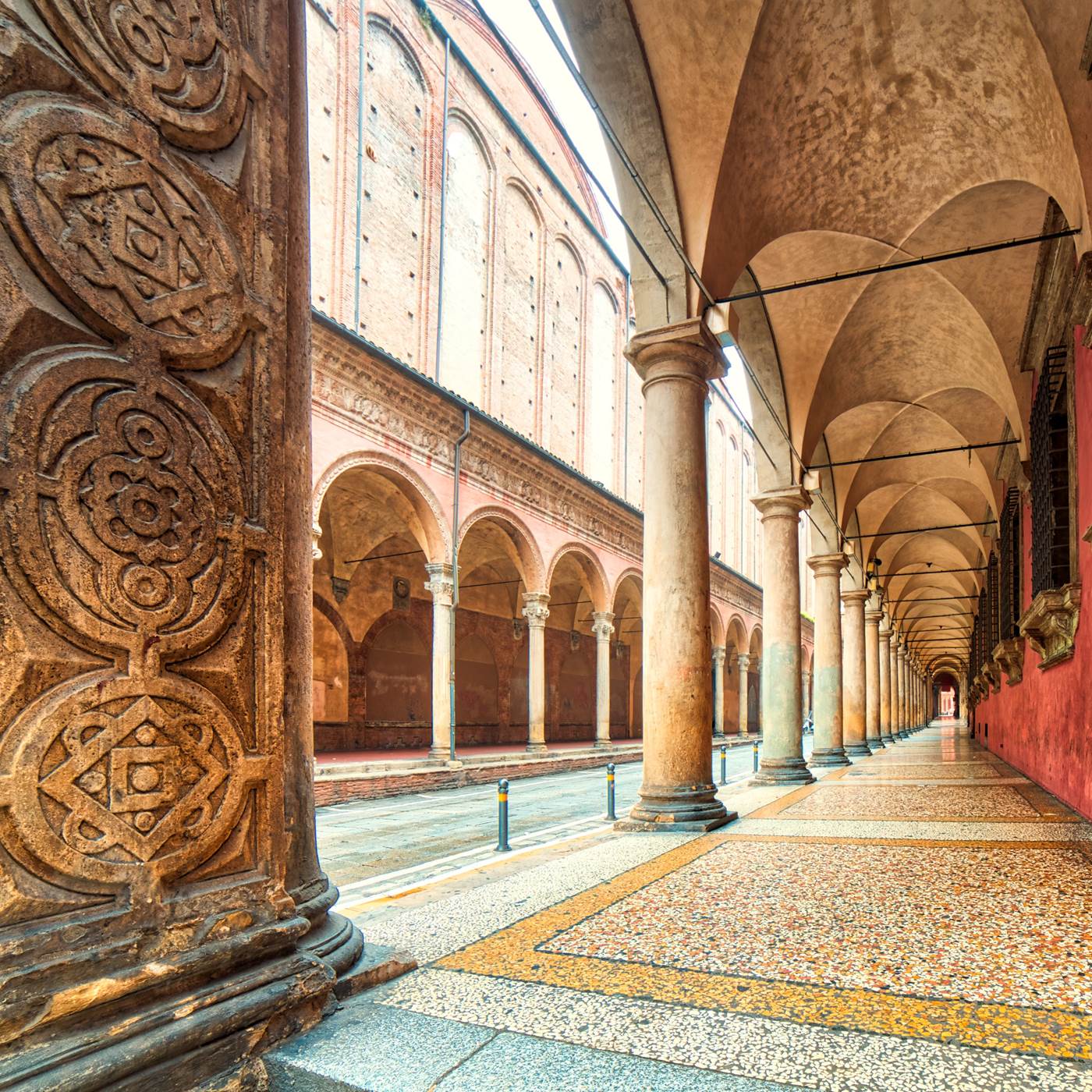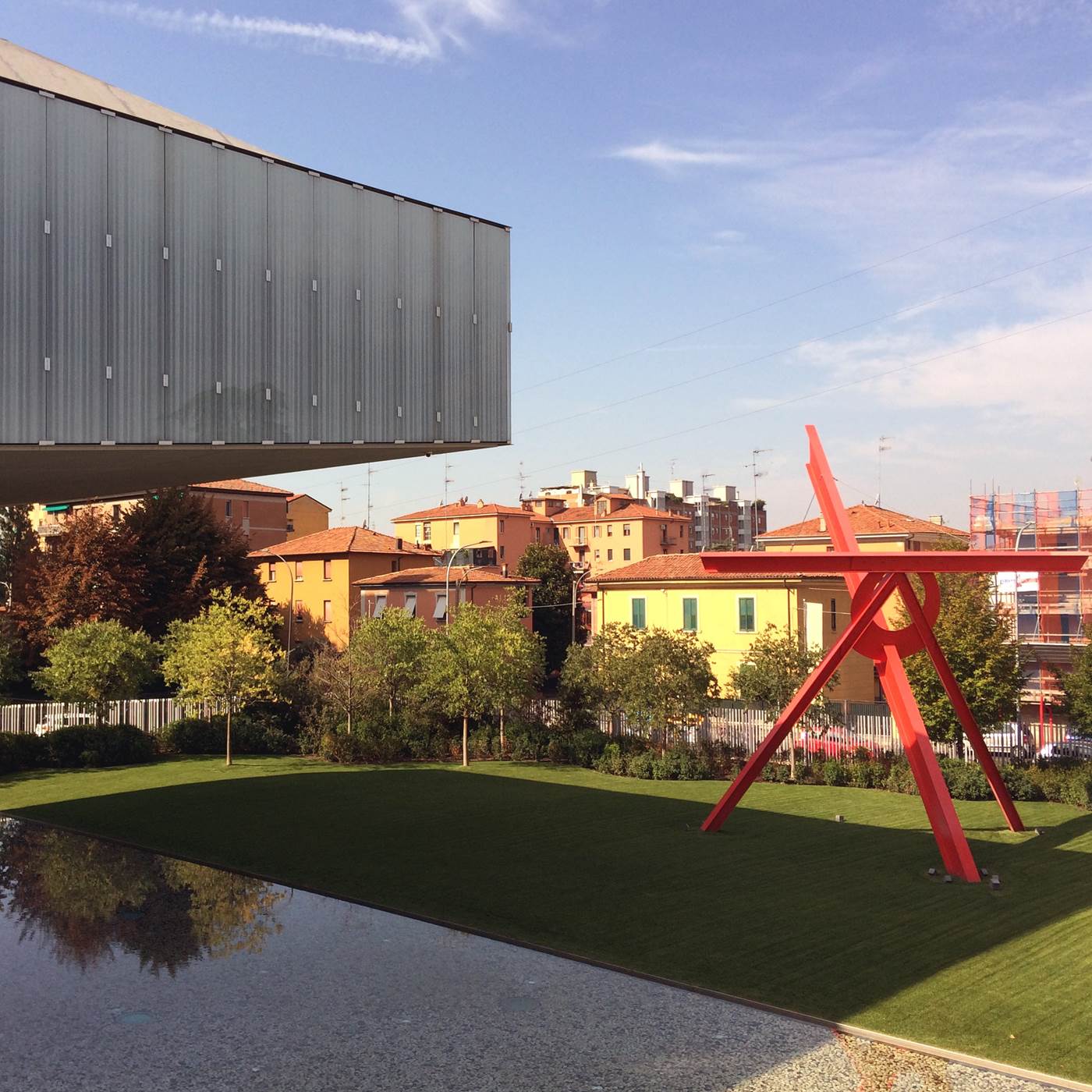A Weekend in Bologna
A trip to Bologna with its ancient architecture, revitalized suburbs, and institutions projected into the future
Bologna is the right size, it’s well-proportioned and easy to get around, welcoming and generous, traditional and experimental at once. You see it immediately in the city’s inclination for earthly pleasures and good living, and yet it’s also a cradle for artists and intellectuals, a centre for student protests and political battles. It’s no surprise that the city has earned a host of nicknames over the centuries: “Bologna the red” for its abundance of medieval buildings and its political ideology, “Bologna city of towers” for the hundred towers that rose above it in the past (and roughly twenty of which are still standing), “Bologna the plump” for its excellent cuisine, “Bologna the learned” as home to Europe’s oldest university

Historic Bologna
For a more informal approach to Bologna, get lost under its endless porticoes, peek into the entrance halls of its historic buildings and glimpse hidden marvels, and discover refined craftsmanship and old-fashioned hospitality in its artisanal shops and boutiques. Since 2021, Bologna’s 38 km of porticoes have been a UNESCO World Heritage site.
That said, there are some things you simply must see such as the artistic and architectural jewels of the historical centre. Starting with Piazza Maggiore, the city’s beating heart since the 13th century. The diversity of the buildings around the square bears witness to the transformations it has undergone over the course of the centuries. Pride of place, naturally, goes to the Basilica of San Petronio, whose first stone was laid in 1390. Antonio di Vincenzo, the architect who designed it, had the lofty ambition (and he probably wasn’t lacking in self-esteem, either) of building the largest church in the world. History took a different course, but today San Petronio is Italy’s fourth-largest church. Then come the 14th-15th century Palazzo dei Notai, Palazzo del Podestà, whose construction began in 1485, the Fountain of Neptune (1563-66) perennially besieged by smartphone cameras, Palazzo d’Accursio, which also functions as City Hall, with its Clock Tower, and the 16th-century Palazzo dei Banchi, which takes its name from money changers’ stands that once crowded its portico. In the middle lies the “crescentone,” a raised rectangle built in 1934, named for its resemblance to Bologna’s traditional focaccia.

A stroll of just over 10 meters beneath the Pavaglione, the 30-arch portico that runs along the side of the Basilica of San Petronio, brings you to the Archiginnasio. Charles Borromeo was instrumental to its conception, and it was built between 1562 and 1563 as a centralized location for university instruction. Architect Antonio Morandi designed the palace, which would remain the university’s focal point until 1803. Take in the courtyard, full of colourful coats of arms honouring 16th and 17th-century professors and students. But within lies something even more fascinating: the 1637, carved-wood-panelled Anatomical Theatre, used for the anatomy lessons of Bolognese architect Antonio Paolucci “il Levanti.”

And who could resist Bologna’s towering leading ladies? The Torre della Garlenda and Torre degli Asinelli, which over the centuries have been both rivals and allies depending on the circumstances, stand guard over the city. Climb to the top of the Torre degli Asinelli and it will also be your compass.
Another magnet for visitors is Piazza Santo Stefano. To some it’s elegant, to others it’s full-blooded and popular. Whatever your take, it certainly is lively because it frequently hosts concerts and events and around it or close by are eateries, bars and shops packed with people. Then there’s the monumental complex of Santo Stefano, also known as “seven churches,” due to the presence of structures built in different periods. Long a Benedictine abbey and currently a Franciscan convent, it has such a long history that you can’t reduce it to a few lines, you have to see it for yourself.

Pop Bologna: Pratello
There’s one Bolognese neighbourhood that has long been the target of dubious adjectives. A crossroads of cultures and lifestyles, good and bad, today it is known as the “street social” quarter par excellence. It’s trendy, sure, but with soul. Without showrooms or banks, it’s empty by day and exuberant by night, from the pre-dinner aperitif on. A multi-ethnic enclave that’s pop and rock, funky and reggae, and just a stone’s throw away from the bourgeois centre. A place where the osterias and bars seem to go on forever, extremely popular for just meeting up, hanging out and being together.
Futurist Bologna
This is a city famed for its glorious and ancient university, the Alma Mater Studiorum founded in 1088, one of Europe’s top institutions of higher learning. But it’s also the city of DAMS, a multidisciplinary artistic degree programme founded in 1971. Against the grain and innovative, anti-conformist and daring, known for its in-class “performances” and VIP instructors, it was once frowned upon by some locals, who saw it as a programme that could only appeal to revolutionaries, drug addicts and slackers. Sometimes, on announcements for apartments for rent, “no dogs” was followed by “no DAMS.” Yet the DAMS programme has continued to prosper, attracting young people from around the world.
And if Bologna was already projected into the future in the 1970s, just imagine today: it’s a pint-sized laboratory of innovation. Bologna moves almost at the speed of a metropolis. Testifying to this are spaces that function not just as showcases, but are also hotbeds of ideas and experimentation. Like MAMbo, located in the ex-municipal oven, a museum that revisits the history of Italian art from the post-World War II years to today; the Fondazione MAST, a factory for the arts and technology, or DumBO, a 40,000-m2 multi-functional district in the former Ravone freight yard where businesses, associations, and institutions coexist and work for the culture, art and jobs of today and tomorrow.
Edible Bologna
In Bologna you’ll be overwhelmed by an irresistible passion for food, and you won’t be able to help letting it show. Gastronomy, after all, is a fundamental part of the Bolognese identity. But beyond the restaurants, Bologna is also a city where socializing revolves around the market. So, dive into the ancient Mercato del Quadrilatero, a market that has been home to artisans and merchants since the Middle Ages. It’s an endless series of stands overflowing with fruit, vegetables, and fish, there are ancient emporiums, shops and historic osterias. Or stop by the Mercato delle Erbe, where you can shop for groceries like a local or just enjoy an aperitif.
USEFUL INFORMATION
Distance from Barberino Designer Outlet to Bologna: roughly 75 km. Travel time: roughly 1 hour
Basilica of San Petronio. Piazza Galvani 5, tel. 051231415,
Palazzo d'Accursio/City Hall. Piazza Maggiore 6, tel. 051203040,
Palazzo del Podestà. Only open for special exhibitions and events
Palazzo dei Notai. Via d’Azeglio 2. Only open for special exhibitions and events
Archiginnasio – Anatomical Theatre. Piazza Galvani 1, tel. 051276811
Torre degli Asinelli. Piazza di Porta Ravegnana
Complex of Santo Stefano. Via S. Stefano 24, tel. 0514983423
MAMbo – Bologna Museum of Modern Art. Via Don Minzoni 14, tel. 0516496611
Fondazione MAST. Via Speranza 42
DumBo. Via C. Casarini 19, tel. 0510493742
in partnership with ![]()
Read next




